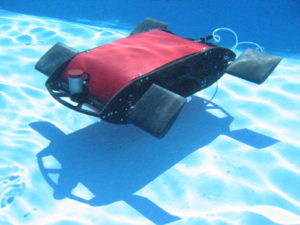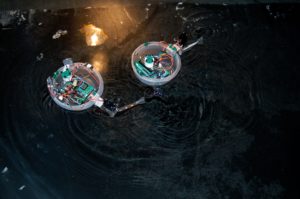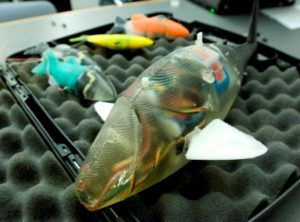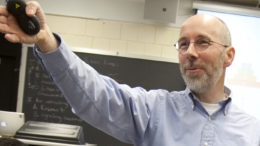Asking when robots will take over the world sounds like a review of Robopocalypse. Yet with recent advances in artificial intelligence, everyone is chiming in on the subject, even the New York Times. How do you separate conjecture from real science? You call an expert! We spoke with John Long, Professor of Cognitive Science and Biology at Vassar College, and Director of the Interdisciplinary Robotics Research Laboratory, about the current state of robotics.
Long is well suited for robotics research. “I started out as a biologist specializing in biomechanics, which studies how animals work by using mechanical principles, looking at animals as machines,” he explains. The corollary is clear: If animals can be studied for their machine-like qualities, why not make machines that mimic animals?

Robot Madeleine, photo credit: John Long
In fact, much of the recent work in robotics has focused on biomimetics— designing technology that imitates nature, a clear reason to blend biology, cognitive science and engineering if ever there was one. Early examples of biomimetic projects include RoboTuna, which studies how fish move as a model for propelling underwater vehicles, or BigDog, a once touted military project to create a pack animal for troops.
Long’s research has focused largely on water creatures. “It’s really complicated to move in the water, yet dolphins can do it easily. That’s what got me into mechanical models of fish and dolphins.”
Long says there are several areas where strides are being made in robotics. “There are so many fields involved in robotics and so many approaches. It is the technology, coupled with artificial intelligence, where we’re putting our money in industry and academia. Globally, tons of money is going into this work.”
In academia, the focus is on exploratory robotics that can help answer questions about how things work. For a biologist like Long, that includes the study of evolution, which is not easy, he says. “Dead fossils tell no tales. But we can make simple models of extinct animals, and then evolve them in a lab and test their evolution.”

Tadro 4 from Vassar’s IRR Lab, photo credit John Long
While a lot of evolutionary studies are done through digital simulations, there are advantages to using physical robots. “By working with physical robots and going slowly with evolution, we get the physics for free,” says Long. That is, digital simulations can be written in such a way that real-life constraints accidentally get ignored, but with physical models, that’s not the case. “We get a lot more accuracy in what we’re trying to understand.”
In industry, Long notes that robotics focus on practical, commercial use. Water-focused robotics like the work his lab does, for example, could be used to activate or deactivate technology in deep waters, track down lost flight recorders, and other underwater uses.
So, will robots take over our future? Long isn’t particularly concerned about it. “I don’t worry about the singularity,” he says. But he does have a few predictions for the near future.

Robo-fish, via robaid.com
In addition to more animal-inspired technology, Long expects to see more breakthroughs in cryptorobotics. These are “hidden” technological systems already in place whether we think about them or not.
“So much of our culture is set up to look for androids,” Long says, “but that’s about 1% of our existing robotics.” Most real tech is focused on robotics we don’t notice, such as the Roomba and your car’s cruise control. Long says we can expect to see existing cryptorobotic systems become more and more advanced, such as cars incorporating radar and lidar.
“We will build our world to be robot friendly,” he says. “As an example, right now we have little robotic cars in our lab. They’re very simple. They can differentiate between a red and green light, and a right and left turn. They can follow a line set into the floor.” One day that tech can be adapted to make an autonomous car that can follow a line set into the middle of a highway lane. In fact, Japan and Korea are building such smart highway systems right now.
Another area of change that Long foresees is a much closer scrutiny of our relationship to machines. People are studying the ethics of robotics and what we create, he notes. Insurance, legalities — all have implications for the future of technology in the human sphere.
The reality is, though, that the future is already upon us. “We’re already living the robotic future,” says Long. Now, we have to adapt to it.

Professor John Long, photo credit Evan Abramson
John Long is Professor of Biology and Cognitive Science at Vassar College, where he also serves as the Director of the Interdisciplinary Robotics Research Laboratory. With help from his students and collaborators, he publishes his research in the fields of biology, computer science, and robotics. His teaching has been featured in “Robotics,” a 24-lecture program created by The Great Courses. He is the author of Darwin’s Devices: What Evolving Robots Can Teach Us about the History of Life and Future of Technology. He served as a robotics consultant for Recursor’s original, award-winning interview series, Nina Unlocked.)